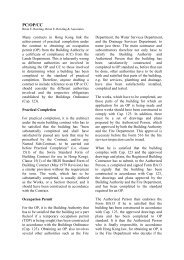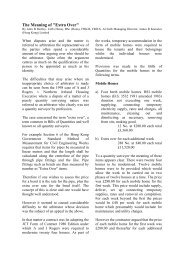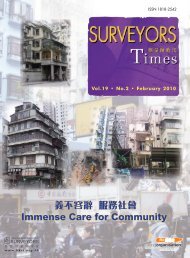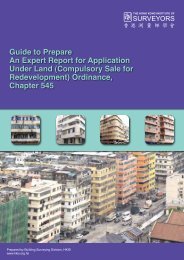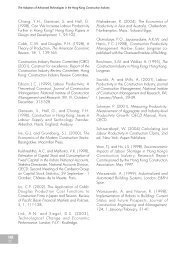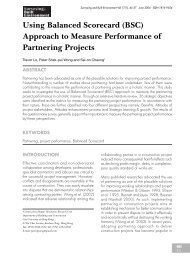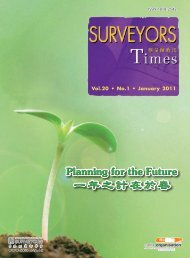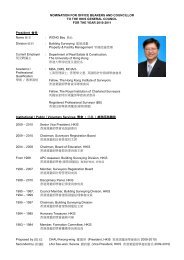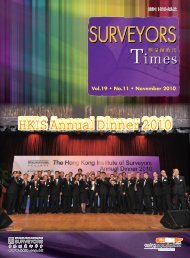Special issue to commemorate the 70th Anniversary of the Battle of ...
Special issue to commemorate the 70th Anniversary of the Battle of ...
Special issue to commemorate the 70th Anniversary of the Battle of ...
Create successful ePaper yourself
Turn your PDF publications into a flip-book with our unique Google optimized e-Paper software.
Decoding <strong>the</strong> Enigma <strong>of</strong> <strong>the</strong> Fall <strong>of</strong> <strong>the</strong> Shing Mun Redoubt Using Line <strong>of</strong> Sight Analysis<br />
INTRODUCTION<br />
Despite <strong>the</strong> widespread recognition <strong>of</strong> <strong>the</strong><br />
importance <strong>of</strong> terrain within military action, it<br />
has been rarely been used as an his<strong>to</strong>rical <strong>to</strong>ol <strong>to</strong><br />
help deconstruct events, actions, and outcomes<br />
<strong>of</strong> military engagements, yet clearly its potential<br />
<strong>to</strong> impact on our understanding <strong>of</strong> such actions<br />
is considerable. In recent years, however, <strong>the</strong><br />
relevance <strong>of</strong> terrain as a <strong>to</strong>ol in <strong>the</strong> his<strong>to</strong>rical<br />
analysis <strong>of</strong> his<strong>to</strong>rical engagements has gained some<br />
momentum…(Doyle and Bennett 2002: 1).<br />
Chinese strategist Sun Tzu (Griffith 1971), wellknown<br />
<strong>to</strong> Western and Japanese military thinkers, had<br />
a sharp focus on <strong>the</strong> importance <strong>of</strong> terrain <strong>to</strong> strategic<br />
and tactical operations (Doyle and Bennett 2002).<br />
The available technology <strong>of</strong> <strong>the</strong> pr<strong>of</strong>ession <strong>of</strong> land<br />
surveying was used <strong>to</strong> help investigate <strong>the</strong> mystery<br />
<strong>of</strong> <strong>the</strong> fall <strong>of</strong> a stronghold at <strong>the</strong> Shing Mun Redoubt,<br />
guarded by <strong>the</strong> famous Royal Scots. This loss was<br />
a significant event during <strong>the</strong> <strong>Battle</strong> <strong>of</strong> Hong Kong,<br />
as it triggered <strong>the</strong> premature abandonment <strong>of</strong> <strong>the</strong> Gin<br />
Drinker’s Line 1 and <strong>the</strong> evacuation <strong>of</strong> <strong>the</strong> mainland<br />
side <strong>of</strong> Hong Kong. The geography and hardware <strong>of</strong><br />
this battlefield, like many o<strong>the</strong>rs in this minor Pacific<br />
<strong>the</strong>ater engagement <strong>of</strong> World War II, have never been<br />
seriously studied by war his<strong>to</strong>rians or heritage <strong>the</strong>orists<br />
in spite <strong>of</strong> a wartime inquiry by British military leaders<br />
in captivity and a postwar Cabinet inquiry in 1958<br />
(Latham 1958). This was so, even though it was<br />
known that Hong Kong was probably one <strong>of</strong> <strong>the</strong> few<br />
places where British pillboxes were in action with <strong>the</strong><br />
enemy during World War II (Osborne 2008: 301) and<br />
<strong>the</strong> defenders in <strong>the</strong> <strong>Battle</strong> <strong>of</strong> Hong Kong inflicted<br />
disproportionately high casualties on <strong>the</strong> enemy<br />
(Lai 2001). The report <strong>of</strong> <strong>the</strong> inquiry, authored by<br />
Brigadier H.B. Latham, Head <strong>of</strong> <strong>the</strong> His<strong>to</strong>rical Section<br />
<strong>of</strong> <strong>the</strong> Cabinet Office, consolidated diverse sources<br />
<strong>of</strong> evidence, naturally all adduced in English, by <strong>the</strong><br />
leaders <strong>of</strong> <strong>the</strong> defence and attack (captured at <strong>the</strong><br />
Japanese surrender in 1945). It was obvious from <strong>the</strong><br />
tenor and wordings <strong>of</strong> <strong>the</strong> Cabinet investigation that <strong>the</strong><br />
British military authorities were not pleased with <strong>the</strong><br />
rapid fall <strong>of</strong> <strong>the</strong> Gin Drinker’s Line, <strong>the</strong> defensive line<br />
that was supposed <strong>to</strong> anchor <strong>the</strong> British defence on <strong>the</strong><br />
mainland side.<br />
As for <strong>the</strong> Japanese vic<strong>to</strong>rs, <strong>the</strong>y treated <strong>the</strong>ir capture<br />
<strong>of</strong> <strong>the</strong> Redoubt as a sumptuous, albeit unanticipated,<br />
success that exonerated Lt. Wakabayashi Touiti, who<br />
attacked on his own discretion and saved him from a<br />
court martial. The report <strong>of</strong> this postwar inquiry (<strong>the</strong><br />
Cabinet Report), when read alongside reliable Japanese<br />
accounts <strong>of</strong> <strong>the</strong> fight, has left more mysteries as <strong>to</strong> what<br />
happened and how during <strong>the</strong> contest for <strong>the</strong> Redoubt.<br />
The most intriguing question found in both <strong>the</strong> British<br />
and Japanese <strong>of</strong>ficial accounts is <strong>the</strong> amazingly<br />
low casualty figures: merely two soldiers on each<br />
side. Ano<strong>the</strong>r intriguing question is that <strong>the</strong> physical<br />
dimensions and design <strong>of</strong> <strong>the</strong> concrete tunnels, which<br />
are pr<strong>of</strong>essionally surveyed, mapped, and reported here<br />
for <strong>the</strong> first time, could not permit large scale hand-<strong>to</strong>hand<br />
fighting, not <strong>to</strong> mention <strong>the</strong> fact that no apparent<br />
war damage was found inside <strong>the</strong> tunnels.<br />
Was <strong>the</strong>re really fierce fighting at <strong>the</strong> Redoubt? Was<br />
<strong>the</strong> Redoubt poorly designed <strong>to</strong> withstand a day attack<br />
when fully manned? This paper seeks <strong>to</strong> provide<br />
informed answers <strong>to</strong> <strong>the</strong>se two questions based,<br />
respectively, on a documentary analysis and a GIS<br />
reconstruction and evaluation <strong>of</strong> <strong>the</strong> design <strong>of</strong> <strong>the</strong><br />
Redoubt.<br />
The documentary study involved a comparison <strong>of</strong> <strong>the</strong><br />
account <strong>of</strong> <strong>the</strong> battle consolidated in <strong>the</strong> Cabinet Report<br />
vis-à-vis Japanese information that was not available<br />
for <strong>the</strong> Cabinet Office’s consideration when it made its<br />
inquiry.<br />
Based on an accurate site survey <strong>of</strong> <strong>the</strong> ruins <strong>of</strong> <strong>the</strong><br />
Redoubt combined with some assumptions about <strong>the</strong><br />
weaponry employed, <strong>the</strong> GIS study reconstructed <strong>the</strong><br />
Redoubt as it was during <strong>the</strong> battle by focusing on <strong>the</strong><br />
arcs <strong>of</strong> fire <strong>of</strong> its five pillboxes and concrete trenches,<br />
which was essential information that had a bearing<br />
on <strong>the</strong> design <strong>of</strong> <strong>the</strong> Redoubt against an attack from<br />
Jubilee Dam (known as <strong>the</strong> “gorge dam” on some<br />
maps), <strong>the</strong> main dam <strong>of</strong> <strong>the</strong> Shing Mun (also known<br />
as <strong>the</strong> Jubilee) Reservoir built across <strong>the</strong> valley <strong>of</strong> <strong>the</strong><br />
Shing Mun River. 2<br />
This paper is <strong>the</strong> result <strong>of</strong> interdisciplinary efforts<br />
by researchers, conversant in English, Chinese, and<br />
Japanese, who specialized in heritage conservation<br />
planning, land surveying, and military his<strong>to</strong>ry. It<br />
publishes <strong>the</strong> key findings <strong>of</strong> <strong>the</strong> first on-ground land<br />
survey by a chartered surveyor <strong>of</strong> <strong>the</strong> Redoubt and has<br />
illuminated a number <strong>of</strong> interesting questions over its<br />
rapid loss by highlighting <strong>the</strong> influence <strong>of</strong> terrain on<br />
a battle (Badsey 2002). These questions were raised<br />
and consolidated by a careful documentary analysis<br />
<strong>of</strong> postwar materials in <strong>the</strong> aforementioned three<br />
languages and settled by digital analysis based on <strong>the</strong><br />
data obtained by a ground survey. The GIS techniques<br />
adopted (ESRI 2002; Dakowicz and Gold 2003;<br />
Forkuo 2008) included those used in typical line <strong>of</strong><br />
sight analysis, which has been growing in importance<br />
in landscape planning and conservation research in<br />
foreign (see, for instance, Lathrop and Bognar 1998;<br />
Germino et al 2001) and local (Mak et al 2005a, b)<br />
situations. In a post-colonial heritage conservation<br />
context, this work follows in <strong>the</strong> footsteps <strong>of</strong> works by<br />
Hill and Lian (1995); Phang (1998), Ko and Wordie<br />
(1996); Henderson (2007); Ip (2007); Lai and Ho (2002,<br />
2003, 2007); and Lai et al (2003, 2007) by <strong>of</strong>fering<br />
an example <strong>of</strong> how geographical information from<br />
archival materials on battles and <strong>the</strong> modeled data <strong>of</strong><br />
battlefields (Pearson 2002) can be jointly used <strong>to</strong> better<br />
articulate <strong>issue</strong>s relevant <strong>to</strong> war his<strong>to</strong>ry and relics<br />
conservation (Smith 1996).<br />
1<br />
For <strong>the</strong> locations <strong>of</strong> <strong>the</strong> pillboxes along <strong>the</strong> Line, see Lai et al. (2009).<br />
2<br />
Ano<strong>the</strong>r reservoir, called Lower Shing Mun Reservoir, was built below Jubilee Dam fur<strong>the</strong>r down <strong>the</strong> Shing Mun Valley through <strong>the</strong> construction<br />
<strong>of</strong> an earth dam from 1963 <strong>to</strong> 1964 <strong>to</strong> increase water supply <strong>to</strong> Hong Kong’s rapidly growing post-war population. The lower reservoir does not<br />
flood <strong>the</strong> battle area or <strong>the</strong> pillboxes guarding <strong>the</strong> valley.<br />
SBE<br />
22




